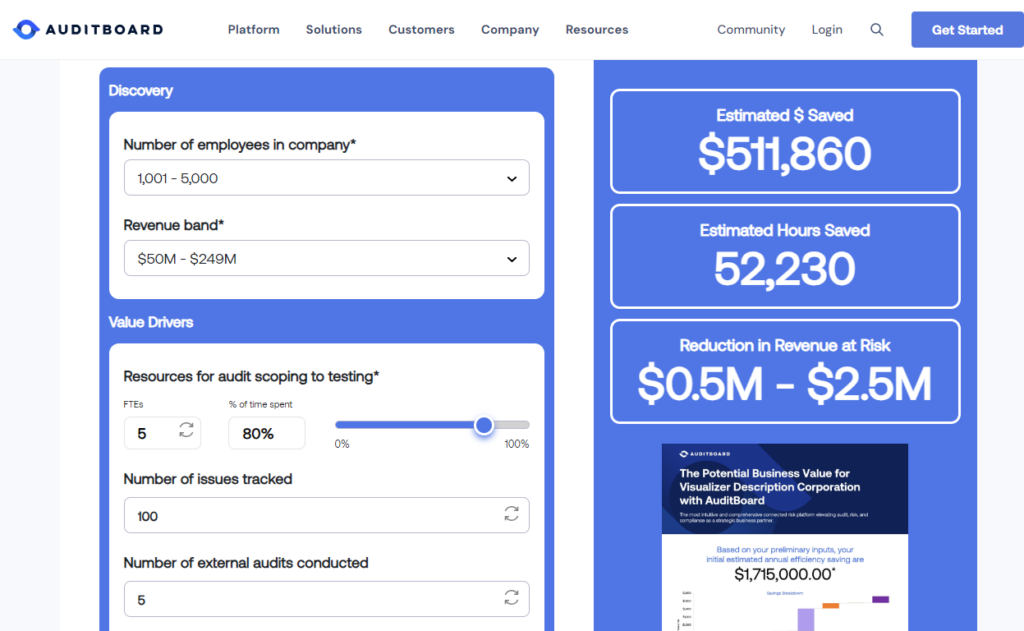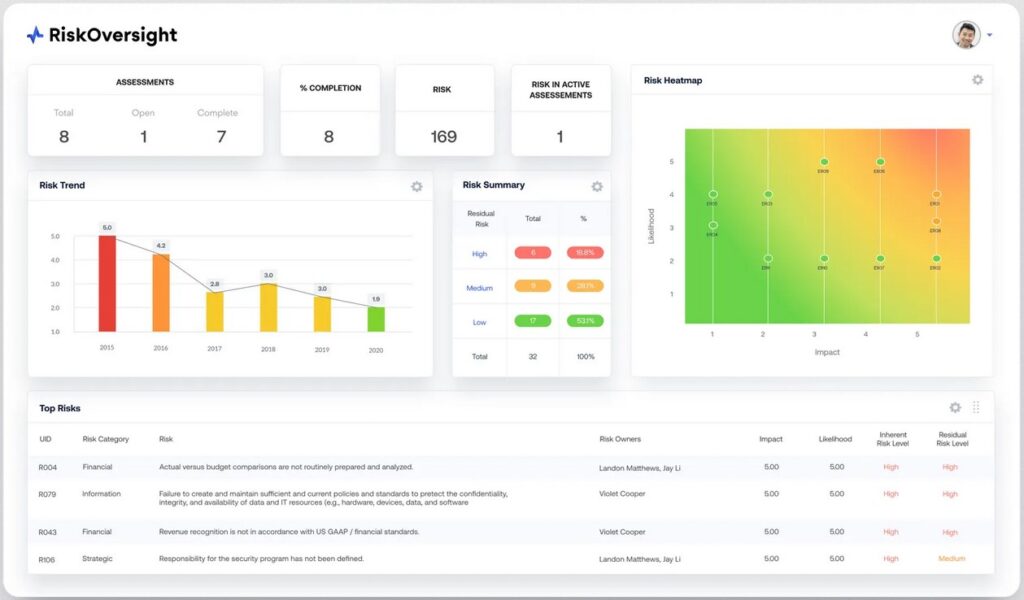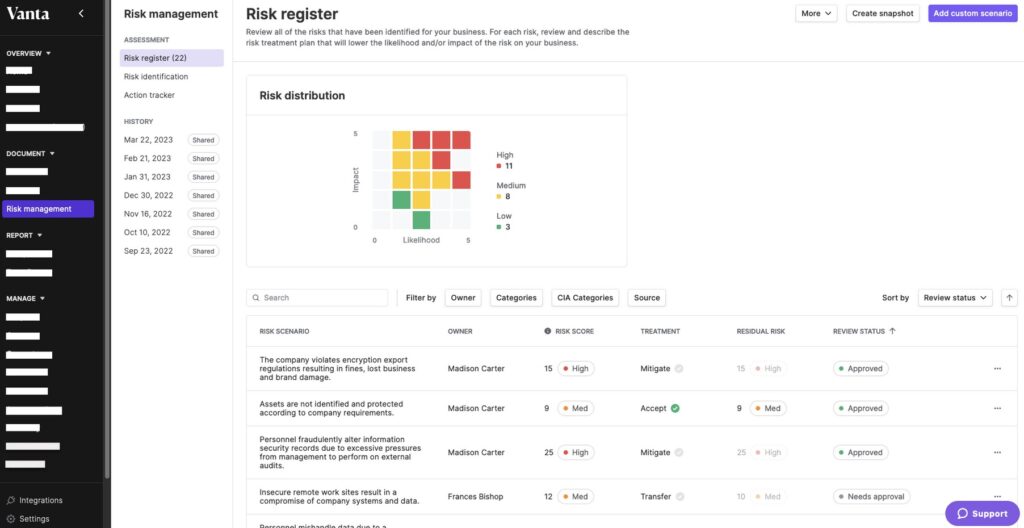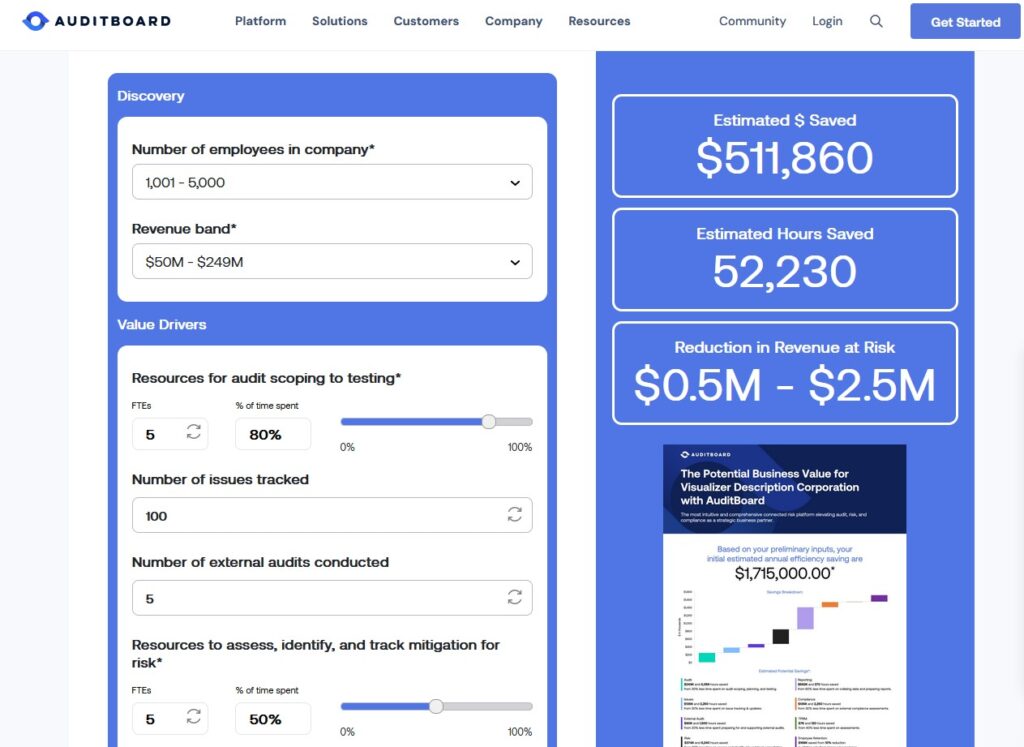The business environment is changing quickly, and you must adapt to thrive in it. From a GRC perspective, two key trends are transforming operations, and they are – growing cyber risks and increasing regulatory fines for non-compliance. Unfortunately, both aspects are complex and resource-intensive, making it difficult for organizations to adapt. Nevertheless, they are essential and non-adherence can negatively impact operations.
In light of such a situation, organizations are turning to compliance software that can automate many administrative and repetitive tasks to save time, cost, and resources while meeting regulatory requirements. That said, not all compliance software is built the same, and you must select the right one based on your compliance requirements and risk strategies.
In this guide, we will review and compare two prominent platforms – AuditBoard and Vanta, to ease your decision-making.
AuditBoard Highlights
AuditBoard is a comprehensive tool for managing risk and compliance throughout your organization. With this platform, you can manage risks better by connecting different stakeholders and operations. Moreover, you can build better partnerships and get everyone on board for improved compliance.
Source: AuditBoard
Here are AuditBoard’s important features.
Connected Architecture
AuditBoard uses a connected architecture with a unified data core to centralize risks, controls, policies, frameworks, and issues. As a result, you have complete control and visibility into every operational aspect. This architecture also supports powerful capabilities like collaboration, automation, streamlined workflows, and more. In all, these aspects enhance overall productivity while reducing non-compliance gaps.
Compliance Dashboards
You can view all compliance-related data in a single dashboard that displays connected metrics and risks. With such views, you can be more effective with risk assessments and identify coverage gaps more accurately. Also, you can understand the gaps and create more effective compliance audit plans to address these gaps.
Reporting
Reports are the window into the state of your operations. AuditBoard creates extensive reports for different purposes and stakeholders, and using this information, you can identify issues and take the necessary actions to address them. Depending on the report type, it can also provide real-time visibility into open issues and help track their progress.
Collaboration
AuditBoard enables collaboration among team members, ensuring that everyone is on the same page when it comes to compliance. Moreover, it streamlines processes and automates workflows for the smooth flow of data across departments, so everyone can gain value from it. AuditBoard also eases the process of conducting internal audits and mapping controls to compliance requirements to streamline the compliance process.
Leveraging AI
AI has been a game-changer across many industries, and GRC is no exception. AuditBoard leverages this power of AI to analyze patterns and provide deeper and more meaningful insights. Moreover, it provides better clarity into specific issues, leading to improved remediation.
Overall, AuditBoard can help you to better handle the potential risks in your environment and meet the compliance requirements of pertinent standards.
Pros:
- Well-designed dashboards and reports.
- Maintains audit trails.
- Version control for documents.
- Evidence collection.
Cons:
- Limited integrations.
- More training can help.
Key Highlights
- Helps identify and fix compliance gaps.
- Performs risk assessments and, accordingly, creates plans to mitigate them.
- Generates well-designed reports.
- Performs compliance audits.
- Enhances communications with stakeholders.
- Leverages AI for better insights.
- Supports ESG compliance.
Vanta Highlights
Vanta is another compliance platform that helps your organization maintain a strong risk and compliance posture. When you use Vanta, you are sending a clear signal about your commitment to security, which in turn can create a positive brand image for your organization.
Source: Vanta
Below are Vanta’s important features.
Easy to Implement
A highlight of Vanta is its ease of use. Right from the time you sign up, Vanta will guide every step. It can tell you when administrators should change controls and configurations, add documents when needed, run tests, and more. Also, its 200+ integrations ensure that Vanta can integrate with your existing framework. You can even tap into its hundreds of pre-built controls that map to the 20+ frameworks it supports. With such a mapping, you are all set to ease compliance within just a few minutes.
Protecting Data Security and Privacy
Vanta focuses greatly on cybersecurity, and this is why it has stringent access controls to streamline access. With Vanta, you can rest assured that only authorized employees view your sensitive data. Moreover, this platform will only access your metadata and not your private data. Besides meeting stringent regulations like GDPR, this approach also helps your customers feel safe.
Automated Workflows
Vanta offers automated workflows that can handle administrative and repetitive tasks. It can even identify gaps and automatically remediate them. With such frameworks, you can better manage vendor risks and ensure their operations don’t pose risks to your organization. Moreover, its automated remediation workflows further reduce the time and effort needed to fix compliance gaps.
Notifications
Vanta continuously assesses your controls and their mapping with compliance standards. As soon as it identifies any non-compliance or failed tests, it immediately sends notifications via email and Slack to the concerned employees. It also provides a detailed context of the issue for faster remediation. In case of minor issues, it automatically remediates using the preconfigured workflows.
In all, Vanta is a platform that provides all the necessary tools and processes to ensure that your data and systems remain safe and compliant.
Pros:
- Intuitive user interface.
- Extensive controls, templates, and integrations.
- Manages vendor risks.
- Automated remediation workflows.
Cons:
- Expensive.
- Limited customization.
Key Highlights
- An auditor portal to understand the state of an audit and take remedial action accordingly.
- Role-based access control.
- Extensive integrations and APIs for custom applications.
- Risk management with a built-in library and controls.
- Extensive reporting.
- Automates gap assessments.
Now that we have an idea about AuditBoard and Vanta, let’s jump into their detailed comparison.
AuditBoard vs. Vanta – A Head-to-head Comparison
AuditBoard and Vanta are excellent choices for managing risks and meeting compliance because of the many common features they share.
Common Features
Below are some aspects you can find on both platforms.
- Both are easy to use.
- Cloud-based SaaS platforms that can be accessed through a web interface.
- Excellent 24/7 customer support through phone and chat.
- Extensive training and documentation.
- Automated workflows.
- Meets multiple compliance regulations like SOC 2, SOX, HIPAA, GDPR, and more.
- Alerts and notifications.
Though AuditBoard and Vanta may seem similar because of their common features, there are also many differences among them. Here are the notable variations.
Compliance Frameworks
When it comes to compliance frameworks, AuditBoard supports more frameworks when compared to Vanta. In particular, it enables you to comply with SOX and ESG frameworks. Vanta, on the other hand, is largely confined to cybersecurity frameworks like GDPR, HIPAA, SOC 2, PCI DSS, and more.
API Access
Vanta integrates with 300+ platforms, including prominent cybersecurity, task, and vulnerability platforms. Moreover, its open API access enables organizations to integrate Vanta with custom applications for streamlined workflows. This flexibility of having an API is missing in AuditBoard.
Focus Area
The focus areas are different for AuditBoard and Vanta. On the one hand, AuditBoard is well-suited for enterprises that need to comply with regulations like SOX. Also, this platform has a wide scope as it covers audit, risk, and compliance management. Vanta, on the other hand, is more suited for startups and small businesses that want to build trust and confidence in the stakeholders’ minds by demonstrating its commitment to meeting compliance and safeguarding data.
Pricing Structure
The pricing structures of the two platforms are vastly different. Vanta offers three plans – Core, Collaborate, and Scale, with each plan being a more advanced version of the earlier one. The Core plan has basic features suited for teams that are just starting while Collaborate encompasses all of Core’s features plus additional ones to suit teams scaling an existing collaboration program. Lastly, Scale includes everything in Collaborate plus features suited for organizations operating in sophisticated security and compliance environments.
AuditBoard, on the other hand, does not have such clearly defined pricing plans. The cost depends on your usage. For example, it depends on the number of employees, issues tracked, the number of external compliance assessments, and more.
While the exact cost is not published by both companies, we can say that AuditBoard is likely to be more cost-effective because you pay for just what you use. With the structured plans in Vanta, you may end up paying for one or more features that you may not use.
Thus, these are the main areas where AuditBoard and Vanta differ greatly.
Final Verdict – Which is Better?
As we wrap up, let’s see which of the two is better.
Overall, AuditBoard is the choice if you are a large organization with an extensive GRC program. This tool can work well for risk management, auditing, compliance, evidence collection, issue remediation, and more. You can even use AuditBoard for SOX and ESG compliance.
On the other hand, Vanta is the choice if you are a small or startup business looking to meet compliance with GDPR, HIPAA, and SOC 2. The scope is narrower than AuditBoard and may not be extensible to some operations like internal auditing, policy management, etc.
We hope this information comes in handy to decide between AuditBoard and Vanta.



